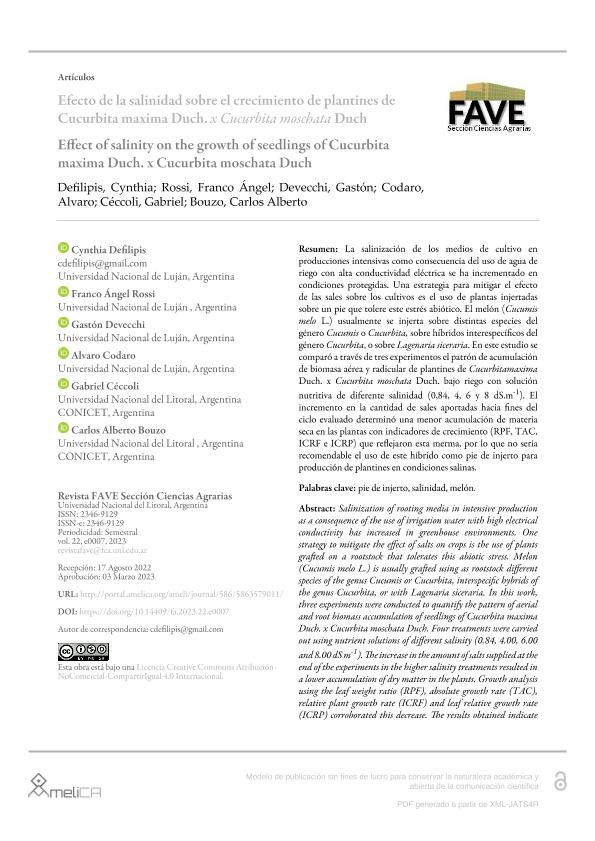Artículo
La salinización de los medios de cultivo en producciones intensivas como consecuencia del uso de agua de riego con alta conductividad eléctrica se ha incrementado en condiciones protegidas. Una estrategia para mitigar el efecto de las sales sobre los cultivos es el uso de plantas injertadas sobre un pie que tolere este estrés abiótico. El melón (Cucumis melo L.) usualmente se injerta sobre distintas especies del género Cucumis o Cucurbita, sobre híbridos interespecíficos del género Cucurbita, o sobre Lagenaria siceraria. En este estudio se comparó a través de tres experimentos el patrón de acumulación de biomasa aérea y radicular de plantines de Cucurbita maxima Duch. x Cucurbita moschata Duch. bajo riego con solución nutritiva de diferente salinidad (0,84, 4, 6 y 8 dS.m-1). El incremento en la cantidad de sales aportadas hacia fines del ciclo evaluado determinó una menor acumulación de materia seca en las plantas con indicadores de crecimiento (RPF, TAC, ICRF e ICRP) que reflejaron esta merma, por lo que no sería recomendable el uso de este híbrido como pie de injerto para producción de plantines en condiciones salinas. Salinization of rooting media in intensive production as a consequence of the use of irrigation water with high electrical conductivity has increased in greenhouse environments. One strategy to mitigate the effect of salts on crops is the use of plants grafted on a rootstock that tolerates this abiotic stress. Melon (Cucumis melo L.) is usually grafted using as rootstock different species of the genus Cucumis or Cucurbita, interspecific hybrids of the genus Cucurbita, or with Lagenaria siceraria. In this work, three experiments were conducted to quantify the pattern of aerial and root biomass accumulation of seedlings of Cucurbita maxima Duch. x Cucurbita moschata Duch. Four treatments were carried out using nutrient solutions of different salinity (0.84, 4.00, 6.00 and 8.00 dS m-1). The increase in the amount of salts supplied at the end of the experiments in the higher salinity treatments resulted in a lower accumulation of dry matter in the plants. Growth analysisusing the leaf weight ratio (RPF), absolute growth rate (TAC), relative plant growth rate (ICRF) and leaf relative growth rate (ICRP) corroborated this decrease. The results obtained indicate that it would not be advisable to use this hybrid as a rootstock for seedling production under saline conditions.
Efecto de la salinidad sobre el crecimiento de plantines de Cucurbita maxima Duch. x Cucurbita moschata Duch
Título:
Effect of salinity on the growth of seedlings of Cucurbita maxima Duch. x Cucurbita moschata Duch
Defilipis, Cynthia; Rossi, Franco Angel; Devecchi, Gastón; Codaro, Alvaro; Céccoli, Gabriel ; Bouzo, Carlos Alberto
; Bouzo, Carlos Alberto
 ; Bouzo, Carlos Alberto
; Bouzo, Carlos Alberto
Fecha de publicación:
06/2023
Editorial:
Universidad Nacional del Litoral. Facultad de Ciencias Agrarias
Revista:
FAVE: Sección Ciencias Agrarias
ISSN:
1666-7719
e-ISSN:
2346-9129
Idioma:
Inglés
Tipo de recurso:
Artículo publicado
Clasificación temática:
Resumen
Palabras clave:
ROOTSTOCK
,
SALINITY
,
MELON
Archivos asociados
Licencia
Identificadores
Colecciones
Articulos (ICIAGRO-Litoral)
Articulos de INSTITUTO DE CIENCIAS AGROPECUARIAS DEL LITORAL
Articulos de INSTITUTO DE CIENCIAS AGROPECUARIAS DEL LITORAL
Citación
Defilipis, Cynthia; Rossi, Franco Angel; Devecchi, Gastón; Codaro, Alvaro; Céccoli, Gabriel; et al.; Efecto de la salinidad sobre el crecimiento de plantines de Cucurbita maxima Duch. x Cucurbita moschata Duch; Universidad Nacional del Litoral. Facultad de Ciencias Agrarias; FAVE: Sección Ciencias Agrarias; 22; e0007; 6-2023; 1-11
Compartir
Altmétricas



